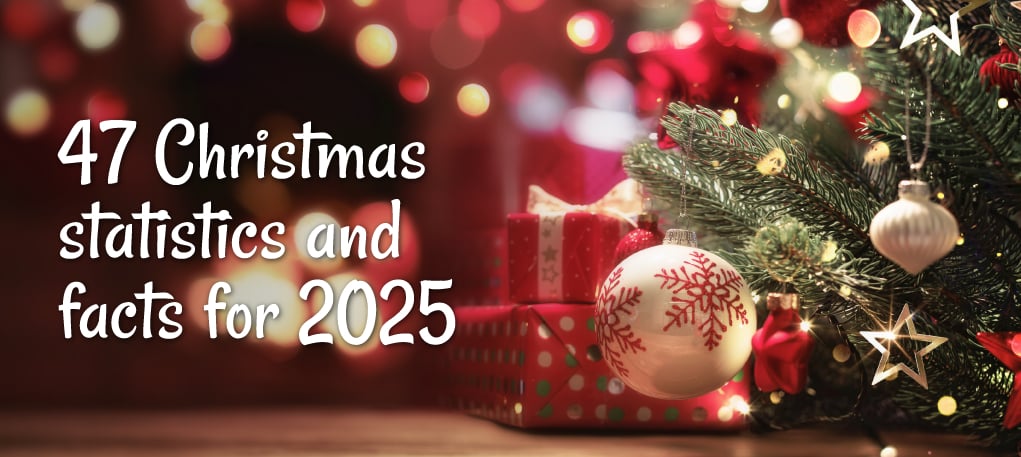
Christmas is, of course, the most wonderful time of the year. However, a lot goes into the big day: the food, the drinks, the travel, the presents, the Christmas tree, and the decorations.
As anyone who's done the gift-buying, dinner-cooking, and planning will know, there’s a lot to juggle.
But how much, exactly? Well, that’s what we’re here to tell you.
Top 10 Christmas statistics and facts
-
People eat around 6,000 calories on Christmas Day → read more
-
11:54am is the average time people will start drinking on Christmas Day → read more
-
Most people will sit down for Christmas dinner at 2pm → read more
-
Toy sales will increase 8% on last year → read more
-
Social media impacts 89% of consumers’ choices → read more
-
55% of people are happy to receive a second-hand gift → read more
-
Nearly 24 million journeys are made on the Friday before Christmas → read more
-
The majority of parents will buy their kids clothes for Christmas → read more
-
Mariah Carey bags an estimated $2.5-3 million a year from All I Want For Christmas Is You → read more
-
The average viewership of The Royal Address has fallen in King Charles’ first three years → read more
Christmas food and drink statistics

-
People eat their way through around 6,000 calories on Christmas Day
Big portions, an extra roastie (if there’s one going spare), selection boxes, and finishing the day with a Baileys all contribute to people eating around 3x as many calories as they need daily.
-
Some people can gain nearly half a stone (2.5kg) during the festive period
All those calories, snacks, cheeseboards, and leftovers add up, contributing to bloating going into the new year. With some people gaining up to 5lbs while they’re celebrating.
-
11:54am – the average time Brits will have their first alcoholic drink on Christmas Day
According to a survey of more than 2,000 people, Brits are more likely to have their first tipple before midday – with Londoners expected to have their first sip at 11:03am.
-
16% of people think 11am is an acceptable time to start drinking on Christmas Day
That’s nearly an hour before the average Brit's first drink. Incidentally, 58% think starting at 1pm is more suitable.
-
Over half (57%) of all drinkers will ‘binge drink’ on Christmas Day
Three-quarters (75%) of 18-34 year-olds, 61% of men and 53% of women will over-indulge this Christmas. Meanwhile, 42% of drinkers aged 55+ are expected to binge drink.
‘Binge drinking’ is defined as over eight units for men and six units for women.
-
2pm is the perfect time for Christmas dinner
Early-mid afternoon is the optimal time for Christmas dinner, with 28% of people choosing to sit down at 2pm. Meanwhile, 3pm (20%) and 1pm (18%) are also popular diners.
The same survey also found that Londoners are more likely to eat later than Northerners, with some in the North East sitting down as early as 11am. That’s not dinner, that’s brunch, right?
Christmas spending statistics
-
Consumers’ expected spend reached a whopping £22.7 billion in 2024
The figure was up 5% on previous years, with shoppers prioritising premium food, new outfits and the latest tech.
-
Brits spent an estimated £433 per person on celebrating the festive period
This is up £17 per person in 2023. People aged 45-54 were the biggest spenders, with an average of £463 per person.
-
Credit card spending increased by 14.5% to £21.9 billion in December 2024
As well as credit card spending increasing, credit card transactions were up compared to previous years.
-
British households spent an average of £460 each on groceries in December 2024
Total spending reached £13.8 billion in the four weeks to 29th December 2024 – an increase of 3.4% (£0.5 billion) compared to the previous year.
-
Nearly half of Britons will spend less on Christmas due to cost-of-living pressures
Of the 48% who won’t be spending as much, almost nine in 10 (86%) said they’ll be cutting money on presents. Meanwhile, only 40% of Brits expect to spend as much on Christmas as they have in previous years.
-
£2.5 billion will be spent on overnight stays during the festive period
8.8 million Brits are expected to plan overnight holiday trips for Christmas and New Year. That works out at £284.09 per traveller on related costs like accommodation.
Christmas presents statistics: What are the most popular gifts?
-
Clothes are the most popular kids’ present
Over half (53%) of parents will buy their kids clothes, shoes and accessories this year.
Board games, card games and puzzles, books, journals and diaries are in the top three, with 39% of parents saying they’ll buy them.
Conversely, only 14% of parents will be buying musical instruments.
-
Toy sales set to increase by 8% this year
Having dropped by almost 4% in 2024, UK toy sales have risen 8% so far in 2025, with adults buying Pokémon cards, LEGO sets, and other collectables driving the increase.
-
LEGO’s popularity builds, selling 2 out of the top 5 gifts
According to search data, LEGO sold two of the top five most popular toys during the festive period last year. Its Disney Stitch and McLaren F1 sets were also joint in the top 10 by its Tiny Plants series.
This, combined with 35% of parents expecting to buy their little ones LEGO and DUPLO sets for Christmas, highlights the Danish brand’s everlasting success and popularity.
Christmas decoration and wrapping statistics

-
47% of people have a distinct colour scheme or theme for their Christmas decorations
Whether recreating a winter wonderland scene with white baubles and fake snow or opting for more traditional decorations, like red and green baubles, a theme can make your home a more coherent space.
Read our guide to explore our favourite Christmas decoration ideas and themes.
-
Two-thirds of Britons who celebrate Christmas use an artificial tree
The same research found that just 15% buy a real tree, with the majority opting for more cost-effective, low-maintenance and convenient artificial Christmas trees.
-
Brits use 227,000 miles of wrapping paper at Christmas
That’s about the distance from Earth to the Moon. And a lot of cellotape.
-
One tonne of recycled wrapping paper saves the equivalent of 17 trees
That’s about the same amount of oxygen that two humans breathe per year. This saves the equivalent of 18 ft2 of landfill space and 4,000kWh of electricity.
For context, Ofgem estimates the typical household in Great Britain uses 2,700kWh of electricity each year.
Christmas travel statistics
-
On average, people will drive 53 miles each way to see their friends and family this Christmas
At least now we have a rough estimate of how far Chris Rea’s drive home for Christmas was.
The same research also found that men (53.7 miles) drive a few miles further than women (50.6 miles).
-
An estimated 23.7 million journeys are made on Friday, 20th December 2024
The AA predicted this would be the busiest day on the roads over Christmas. It certainly makes sense, with it being the last Friday before Christmas.
The next busiest days were the 21st and 23rd of December, with the AA estimating 22.7 million journeys on these days.
To help you plan your route, the last Friday before Christmas in 2025 is the 19th December.
-
Stansted and Manchester are the busiest airports for those celebrating Christmas abroad
500,000 people were projected to depart from each Airport, with an extra 400,000 leaving Luton, 200,000 departing from Birmingham, and 175,000 jetting off from Bristol.
-
Heathrow saw a 13% rise in passengers flying on Christmas Day
160,000 passengers took off from Heathrow on 25th December, helping Heathrow achieve its busiest ever December, with over 7 million people departing from the UK’s biggest airport.
-
15% of Brits dined out on Christmas Day
Over a third of respondents to OpenTable’s survey were dining out for the first time, highlighting an increase in people giving their ovens a Christmas off.
-
Young’s pubs saw a 30% growth in festive diners in London and the South East
Festive bookings increased above pre-pandemic levels in 2024, as office parties and family gatherings also contributed to uplifts in bookings for Greene King (12%) and Mitchells & Butlers (9%).
-
Dining out on Christmas Day in London costs approximately £92 per person
This is £19 above the British average of £73 and an 80% increase on the average cost of £51 in Northern Ireland.
Those London prices, eh.
Christmas tradition and culture statistics

-
Over 12 million tuned into the Gavin & Stacey finale on Christmas Day
Nearly 3 million more people watched Nessa and Smithy finally get together than watched the latest instalment of Wallace and Gromit (9.38 million), which was the second most-viewed.
In total, over 19 million people watched Gavin & Stacey in the seven days after it first aired.
-
Royal Address viewers drop in Charles’ first three years
An average of 7.8 million viewers have watched King Charles’ first three speeches, in 2022, 2023 and 2024.
This is a drop of half a million compared to Queen Elizabeth II’s last three speeches, in 2019, 2020 and 2021 (8.3 million on average).
-
However, King’s speech viewership increased by nearly a million people in 2024
6.82 million people tuned in to watch the King’s Christmas message in 2024, an uplift on the 5.9 million viewers in 2023.
-
Elf is the UK’s favourite Christmas film
YouGov data shows Elf is Britain’s favourite Christmas film. Home Alone’s a close second with 12% of the vote, while Die Hard is third with 8%.
-
46% of Britons don’t consider Die Hard to be a Christmas film
Despite taking place at an office party on Christmas Eve and the soundtrack featuring four (4) Christmas songs, only 37% of Brits consider it a Christmas film.
Bruce Willis agrees with the majority, too, saying, "Die Hard is not a Christmas movie. It's a god damn Bruce Willis movie."
By contrast, the film’s director and scriptwriter have said it is a Christmas film.
We’re none the wiser.
-
All I Want for Christmas Is You is Spotify’s best loved Christmas song
Data from Spotify shows that Mariah Carey’s 1994 single has received over 2.18 billion streams – nearly 300 million more than Wham’s Last Christmas.
Elsewhere, Brenda Lee’s Rockin’ Around the Christmas Tree and Santa Tell Me by Ariana Grande both have 1.29 billion streams.
Michael Bublé completes the top five – his cover of It’s Beginning To Look A Lot Like Christmas has 1.18 billion streams.
-
Mariah Carey makes an estimated $2.5 million in royalties from All I Want for Christmas Is You EACH YEAR
Other calculations have put the figure closer to $3 million. Not bad for a song that’s over 30 years old and can only be listened to for about four weeks per year.
-
Charity donations are estimated at £2.8 billion in November and December
According to research, the British Public was estimated to donate £2.8 billion to charities in the last couple of months of 2024.
Additionally, 50% of people say they always or usually give money to charity over the festive period, compared to the 34% of people who donate throughout the rest of the year.
-
Giving presents is the most popular Christmas tradition, but only 51% will be putting them in stockings
96% of those celebrating Christmas give presents, but only 36% will put presents in stockings.
However, this increases to 51% when looking at those celebrating Christmas with a child under 10.
Elsewhere, 94% will eat Christmas dinner, and 84% will put up a tree.
If you’re part of the 16% that won’t be putting a tree up, e.g. because you don’t have one, explore our range of artificial Christmas trees, including trees of all sizes, from mini and small trees up to 20ft+ Christmas Trees.
We even have different coloured trees, including traditional green Christmas trees, snowy Christmas trees, and black Christmas trees.
Christmas social media trends and statistics

-
Internet usage drops by over a quarter on Christmas Day
Compared to the previous week, internet usage is down by 26% on Christmas Day, with usage down by nearly a fifth on Christmas Eve.
-
Nearly 3 million #Christmas videos posted to TikTok
This is up 52% on the year before and may climb again as content creators look to capitalise on the hashtag’s 11.8% engagement rate, which is far higher than the platform’s average engagement rate of 1.5%.
-
Social media impacts 89% of consumers’ shopping
Engagement rates also seem to increase around the holiday season, with nearly 90% of users saying social media impacts their shopping decisions.
Looking ahead to this Christmas, more than two-fifths (42%) of consumers plan to use social media for gift ideas.
-
#HolidayShopping posts increase by nearly 3 times after Halloween
If you think the festive period starts as soon as Halloween ends, you might be on to something.
TikTok saw a 190% increase in #HolidayShopping videos published the week after Halloween, highlighting just how quickly attention turns to Christmas after spooky season ends.
The environmental impact of Christmas
-
Shoppers are expected to spend £2.05 billion on second-hand gifts
84% of consumers have said they’re likely to spend a portion of their gift budget on pre-loved items.
The demand for second-hand gifts is mainly driven by a desire to save money and the ability to find rarer, more unique items.
Millennials (those aged 24-35) and Gen Z are also most concerned about how much is wasted at Christmas.
-
55% would be happy to receive a second-hand gift
Good news if you’re thinking of scouring the second-hand market for Christmas gifts this year! Over half of all people would be happy to receive a pre-loved present.
This number gets even higher for 18-24 year olds, with 74% happy with second-hand gifts.
By comparison, less than half (46%) of people surveyed over the age of 55 would be happy to receive a second-hand gift.
This age group is also only 13% likely to buy a second-hand gift for someone else.
-
58% are unlikely to buy a second-hand gift for someone else
Despite most people being happy to receive pre-loved presents, the majority won’t be buying them for people.
Again, younger demographics are more likely to buy second-hand gifts. Under a third (29%) of 25-34-year-olds and 27% of 18-24-year-olds consider themselves very or fairly likely to purchase a second-hand present.
-
70% buy second-hand gifts to save money
With the nation’s belt collectively tightening due to inflation and an increased cost of living, it’s not surprising that people are looking to second-hand sites like Vinted and eBay for Christmas presents.
Another big factor is sustainability; 55% of those surveyed said they would buy pre-loved items to reduce their carbon footprint.
-
£700 million spent on unwanted gifts in the UK
£42 million of this is thrown away and sent to landfill. Staggeringly, only 1% of Christmas gifts are still used six months after December 25th.
-
The UK typically produces an extra 30% of waste during the festive period
Compared to the rest of the year, a typical UK household will throw away more than three bin bags full of wrapping and packaging every year.
-
4.5 million Christmas dinners are thrown away each year
261,000 turkeys, 7.5 million mince pies, 760,000 and, most upsettingly, 11.3 million roasties are binned each Christmas.
-
Approximately 6-8 million real Christmas trees are sold each year
It is estimated that this creates between 9,000 and 12,000 tonnes of waste. Rotting Christmas trees also produce 100,000 tonnes of toxic gases, including methane, which is 25 times more potent than carbon dioxide.
Christmas Tree World is the UK’s leading retailer of artificial Christmas trees, decorations and lights. We stock Christmas trees of all sizes and for all events, from cosy family Christmases to grand commercial celebrations.
Sources
-
https://www.bda.uk.com/resource/eat-drink-and-be-healthy-this-christmas.html
-
https://www.theguardian.com/lifeandstyle/2013/dec/22/christmas-day-first-drink-by-11am
-
https://media.drinkaware.co.uk/media/rqafhvzm/festive-drinking-patterns-report.pdf
-
https://www.countryandtownhouse.com/food-and-drink/most-popular-time-christmas-dinner/
-
List of toys taken from https://www.toyretailersassociation.co.uk/dreamtoys-2024/ with search data from https://ads.google.com/home/tools/keyword-planner/
-
https://retailtimes.co.uk/next-shares-this-years-christmas-decor-trends/
-
https://yougov.co.uk/society/articles/44777-two-thirds-britons-who-celebrate-christmas-will-ha
-
https://www.businesswaste.co.uk/christmas-waste/reducing-christmas-wrapping-paper-waste/
-
https://futuretransport-news.com/how-far-will-you-drive-this-christmas/
-
https://www.theaa.com/about-us/newsroom/christmas-getaway-2024
-
https://www.abta.com/news/millions-head-abroad-great-christmas-and-new-year-getaway
-
https://press.opentable.co.uk/opentable-reveals-christmas-dining-habits/
-
https://www.independent.co.uk/news/uk/boris-johnson-barb-horses-covid-itv-b2674623.html
-
https://www.radiotimes.com/tv/current-affairs/kings-christmas-speech-ratings-2023-newsupdate/
-
https://yougov.co.uk/entertainment/articles/33528-public-has-spoken-elf-best-christmas-film
-
https://yougov.co.uk/entertainment/articles/44821-brits-dont-think-die-hard-christmas-film-results-a
-
https://www.cnet.com/culture/entertainment/bruce-willis-die-hard-is-not-a-christmas-movie/
-
https://yougov.co.uk/society/articles/48208-how-do-britons-celebrate-christmas
-
https://ads.tiktok.com/business/library/TikTok_Holidays_For_You_2024_Vertical_Playbook.pdf
-
https://keenanrecycling.co.uk/jingle-all-the-way-to-a-waste-free-christmas-minimise-food-waste/
-
https://www.businesswaste.co.uk/news/christmas-waste-facts-its-not-very-jolly/











